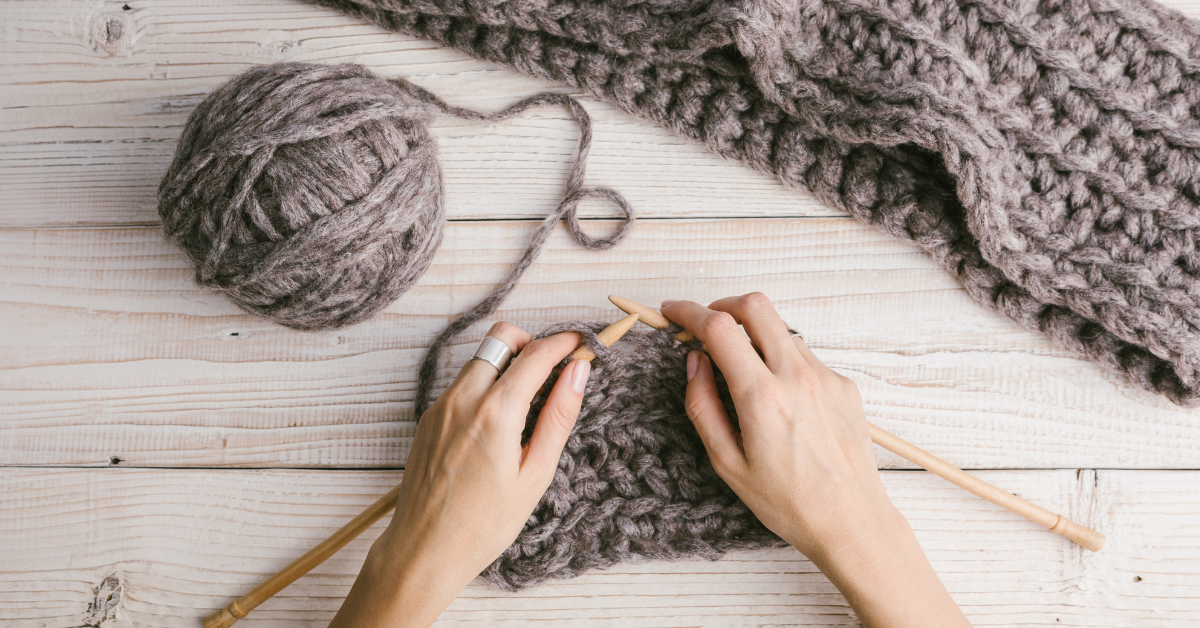Back in the summer of 2008, I was a hormonal and anxious new mother when I picked up a book I’ve never forgotten, as it left me emotionally destroyed. Comfort: A Journey Through Grief, by Ann Hood, is a searing memoir detailing the author’s abrupt loss of her 5-year-old daughter, Grace, to a virulent form of strep, and how the act of knitting became central to rebuilding her life after the tragedy.
Hood, an accomplished novelist and avid reader prior to her daughter’s death in 2002, found herself unable to read or write for almost two years after Grace’s passing. On the advice of friends, she learned to knit, a pastime that became a source of solace.
“I often say that I knit my way back from grief,” Hood writes on her website. “Soon I was reading again, and then, finally, writing again.”
In 2007, Hood published The Knitting Circle, an autobiographical novel about a mother who loses her only child and joins a knitting group to distract from her grief. The following year, she published Comfort, her real-life account of the unspeakable heartache she endured.
“Knitting saved my life,” Hood writes in the memoir.
“Unlike life, or at least this new life of mine–in which I was forced to keep moving forward through the mess it had become–knitting allowed me to start over and over again, until whatever I was making looked exactly as I wanted it to look.”
As stress and anxiety levels surged during the pandemic, so too did the popularity of knitting, with everyone from Michelle Obama to British Olympic diver Tom Daley (not to mention my own sister) taking up the therapeutic needles in search of stress relief and relaxation.
Clips of Daley, who won gold and bronze medals in Tokyo, went viral when cameras caught him knitting in the stands in between Olympic events.
“One thing that has kept me sane throughout this whole process is my love for knitting and crochet and all things stitching,” Daley said in a video on his knitting Instagram account, @madewithlovebytomdaley, which has 1.4 million followers to date.
Hood, too, has continued to find salvation through knitting during the pandemic. In the early days of lockdown, as so many of us grappled with what to do with ourselves during our homebound hours, she penned an Op-Ed in the Los Angeles Times headlined, “Knitting is my therapy during this pandemic.”
“From the safety of your very own living room, you can order yarn and needles, watch knitting tutorials, move stitches from one needle to the next, almost like some of us move the beads of a rosary in prayer,” she advised. “Knit for all the storms coming our way. Knit to soothe your frightened self. Take a deep breath. Knit.”
That knitting became a source of comfort to so many in COVID times was no surprise to Vermont-based knitting expert, educator and author Beth Brown-Reinsel, who said a similar knitting boom occurred in the wake of the events of Sept. 11, 2001.
“Just like the public response after 9/11, the pandemic caused a collective shift towards the basic things of life: baking bread, family game night, and knitting, among many other pursuits,” she said via email.
“These activities give us a sense of groundedness, help us to feel more secure, while making something that is useful. I think ‘making’ in general is the key. Using our hands to create helps soothe the trauma we experience.”
Brown-Reinsel, who has been teaching knitting nationally and internationally for over 25 years, said she’s seen increased interest in her workshops* since the pandemic, and no sign that the knitting craze is waning.
“As the vaccines roll out, the urge to get back to in-person retreats and knitting cruises is palpable, and my own workshop and travel schedule, as well as that of many other knitting teachers, is filling up for the next few years,” she said. “For example, I’m taking a group of knitters to Wales and Cornwall next year, one of three international trips for 2022 on which I will be teaching.”
As far as her teaching philosophy is concerned, Brown-Reinsel feels strongly that the true goal of knitting should be enjoyment, not perfection.
“I believe mistakes are learning tools,” she said. “Certainly I didn’t always feel that way, especially in the beginning when I first learned to knit. But I do now, even if the mistake reminds me to be more mindful of what I am doing. My advice is to be patient and kind to yourself.”
To Brown-Reinsel, knitting is a means of honoring and preserving the historic practices of knitting.
“I love the fact that as I knit, I feel connected to knitters of older times who were clever and creative but who had few opportunities to develop those skills except through knitting or other handwork,” she said. “They worked hard and knitted often late at night to clothe their families, to keep them warm.
“There is always more to learn about knitting. It can be as simple or complex as you want, depending on how much you want to research and experiment.”
*For those who can’t make it to one of her in-person workshops, Brown-Reinsel provides a wealth of information on her website, and also has a Patreon offering different levels of membership. You can view her AuthorPods profile here.
Here’s a selection of recommended knitting books, for novice, advanced and even non-knitters alike:
Knitting Ganseys, by Beth Brown-Reinsel
This revised edition of Brown-Reinsel’s original 1993 bestseller was published in 2018, and features all-new step-by step photography, new patterns for sweaters in the traditional gansey style, and explorations of modern gansey-inspired patterns. Brown-Reinsel also shares a variety of traditional gansey techniques and construction methods, as well as contemporary sources for yarns.
Beth Brown-Reinsel recommends:
Estonian Knitting 1: Techniques and Traditions
Estonian Knitting 2: Socks and Stockings
“I am mesmerized by the recent books on Estonian knitting. Books 1 and 2 have been released, and I am waiting for Book 3! What a wealth of techniques! I could create workshops for years from those two books.” -BBR
Stitch ‘n Bitch: The Knitter’s Handbook, by Debbie Stoller
In her irreverent and engaging take on knitting “how-tos,” Stoller provides step-by-step illustrated techniques for the beginner up to the advanced knitter. She suggests essential tools to keep on hand, and even has a chapter on correcting common errors, “Oops, I Knit it Again: The Stitch Doctor’s Guide to Fixing Mistakes.” Also included: an eclectic assortment of patterns.
Knitting Without Tears, by Elizabeth Zimmerman
After Zimmerman’s death in 1999, her New York Times obituary lauded her for “revolutionizing the ancient art of knitting.” First published in 1971, Knitting Without Tears has never been out of print, and remains widely regarded as the quintessential knitting bible.
Vogue Knitting: The Ultimate Knitting Book, Vogue Knitting Magazine
First published in 1989, this comprehensive knitting resource was updated in 2018 with extensive new material on the latest knitting advances, techniques and patterns. An essential guide for modern knitters of all abilities.
No Idle Hands, by Anne McDonald
In No Idle Hands, McDonald, a historian and lifelong knitter, explores the history of knitting in America and the ways in which it shaped women’s lives, from colonial times up to the book’s publication in 1988. Using primary sources such as letters, diaries, vintage articles and advertisements, McDonald provides a fascinating look at how knitting influenced society’s view of women, as well as how women viewed themselves.
Vanishing Fleece: Adventures in American Wool, by Clara Parkes
Author and yarn critic Parkes invites the reader on her fast-paced cross-country quest to transform a 676-pound bale of fleece into saleable yarn, providing a behind-the-scenes look at the endangered wool industry along the way.





Hi Beth,
I have enjoyed several of your classes, and always read your monthly newsletter. I was raised in suburban New York, near Connecticut border, so had plenty of use for mittens then. Most of my adult life has been in California, San Francisco first and the central coast for over fifty years. So, I do not have much use for mittens now. I still enjoy your monthly newsletter. Will you be a Stitches West 2022? A group of us from this area, are planning to go up by train. We can knit, talk, enjoy scenery and don’t have to worry about traffic.
All the best to you and your family.
Anne